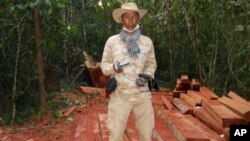With at least four Cambodians killed in recent years trying to uncover environmental crimes, the country ranks as the “deadliest” place in the world to conduct such reporting, according to a new report.
Compiled by the Paris-based organization Reporters Without Border (RSF), the report, “Hostile Climate For Environmental Journalists,” names Cambodia—alongside India—as one of the two “deadliest countries” for journalists covering environmental issues.
“Many environment journalists have paid a high price,” read the report, citing a worldwide tally of 10 murders of environment reporters since 2010.
RSF said four of the murders took place in Cambodia, where the group alleged “disgraceful impunity” for perpetrators.
“RSF has urged the authorities in both [Cambodia and India] to conduct serious and transparent investigation into these barbaric murders of journalists with aims to bring those responsible to justice,” the report said.
The cases in Cambodia began with the gunning down of prominent environmentalist Chut Wutty in 2012, while he was guiding two reporters from the local English-language newspaper The Cambodia Daily near a protected area of Koh Kong province.
“The Cambodian judicial authorities closed the Chut Wutty murder case in 2012 after botching the investigation,” it said. A court ruled that Chut Wutty’s death was an “accidental killing” after a probe and court case that rights groups said both lacked credibility.
Also in 2012, Virakchun newspaper reporter Hang Serei Udom was found hacked to death in the trunk of his car in Ratanakiri province. In 2014, logging-focused reporter Taing Try was killed in Kratie province, and in the same year, reporter Suon Chan was killed while covering illegal fishing in Kompong Chhnang province.
Besides Cambodia and India, RSF’s report also highlighted the risky conditions for reporting about environment and climate change in the Philippines, Indonesia and Russia.
Ouk Kimseng, under-secretary of state at Cambodia’s Information Ministry, acknowledged the claim that journalists working in some remote areas face a threat to their security when covering environmental issues.
However, Kimseng said, it was the responsibility of journalists to be careful when they report in dangerous areas. “Regarding their security concerns, we can only suggest they [journalists] think twice or inform the authorities on the ground,” he said.
The official also suggested that the report’s authors should have done more research within Cambodia.
“In their further reports on the topic, I think [RSF] should come to the ground, meet those journalists, and compile the information like that,” Kimseng said. “So we can explore on how confrontational they are when going to the fields.”
Reports of journalists killed in remote parts of the country have often been accompanied by allegations that reporters themselves in these areas are acting unethically. Particularly in the northeast of the country, where illegal logging is rife, journalists have been accused of demanding bribes from illegal loggers and companies in order to suppress their own reporting on forestry crimes.
Sek Borisoth, head of the Cambodian Journalists’ Council for Ethics, said that reporters should not have to work under the threat of violence, regardless of these ethical concerns. The “hostile climate” faced by environmental reporters was damaging to Cambodian society as a whole, he argued.
“No matter how unethical they are in some cases, environment journalists do not deserve in any way to face killing or violence,” Mr. Borisoth said. “Journalists must always be protected and safe.”







